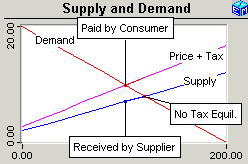Economists and state legislators disagree about who pays a sales tax, the business ringing up the sale or the shopper handing over the cash. Economists think that, if the legislators increase a sales tax rate, then the burden of the tax can fall on either party, depending on the nature of the market for the good being sold.
![]() Model Link:
Who Pays a Sales Tax?
Model Link:
Who Pays a Sales Tax?
<activate the model links>
Printable PDF Exercises
The EconModel analysis of this issue has the following steps:
-
 Draw the Diagram
Draw the Diagram
Draw and explain the demand curve, the supply curve, and the supply curve plus tax.
- Find the Equilibrium
Explain why the equilibrium quantity is where the demand curve intersects with the supply curve plus tax.
- Who Pays a Sales Tax?
Show that sales tax is effectively split between the supplier and the purchaser.
Something to Think About
Nominally, the employer and employee each pay one-half of the Social Security
taxes associated with an employee. Who really pays Social Security taxes?
Would it change the effective burden of a 6% sales tax if it were divided into
two 3% taxes, one "paid by the purchaser" and one "paid by the merchant"?
- Analyze the Slopes
Show that the split of the tax between the supplier and the purchaser depends on the slopes of the demand and supply curves.
- Revenue Maximizing Tax
Find the tax rate that maximizes tax revenues.
- The Laffer Curve
Show that tax revenues can actually increase when tax rates are cut.
Classic Economic Models
Microeconomics
Introduction
Overview of Micro Models
Supply and Demand
Basic Supply and Demand
Who Pays a Sales Tax?
The Cobweb Model and
Inventory-Based Pricing
Theory of the Firm
Perfect Competition
Monopoly and
Monopolistic Competition
Price Discrimination
The Demand for Labor
Theory of the Consumer
Two Goods - Two Prices
Intertemporal Substitution
Labor Supply, Income Taxes,
and Transfer Payments
Macroeconomics
Introduction
Overview of Macro Models
Models in Chronological Order
The Classical Model
The Simple Keynesian Model
The Keynesian IS/LM Model
The Mundell-Fleming Model
Real Business Cycles
The IS/MP Model
The Solow Growth Model
Financial Markets
Utility-Based Valuation of Risk
Mean-Variance Analysis:
Risk vs. Expected Return
Fixed Income Securities:
Mortgage/Bond Calculator
Growth Investments:
Present Value Calculator
Resources